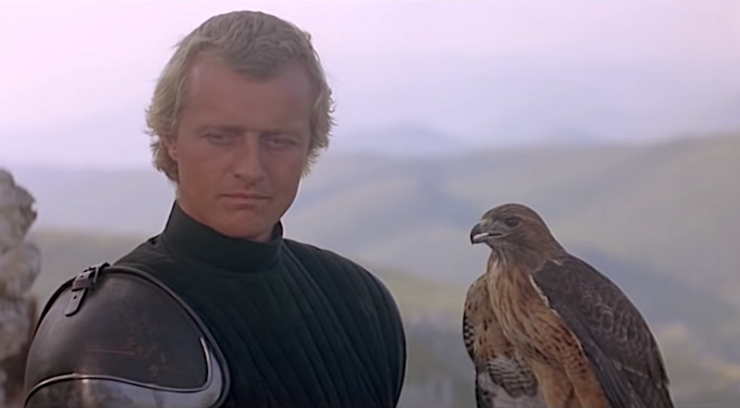Some people love birds. Some people bird watch, or even have birds as pets. And we’re sure they’re lovely birds. But we really wish we had magic birds. That’s the goal, right? We maybe think about this too often. So here is our ode to fantasy birds!
Hugin and Munin—Norse Mythology
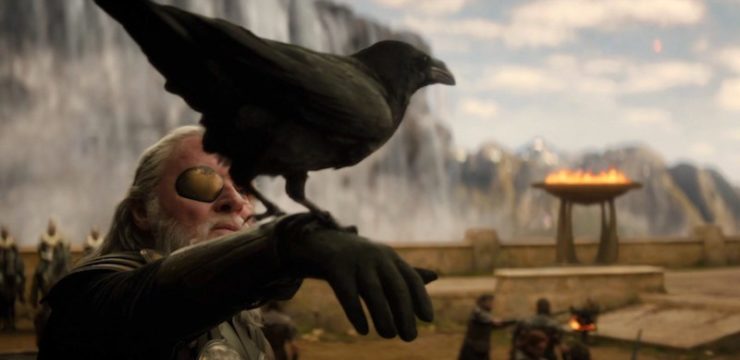
Odin the Allfather has not one but two! two whole ravens. According to 13th century historian/poet Snorri Sturluson, Hugin and Munin leave Odin every morning, flying around the world, and are back by breakfast time. This is how Odin keeps an eye on things. Roughly translated, their names mean “Thought” and “Memory” (memory is the rougher translation of the two), so these are no ordinary ravens. They are the personification of ideas, and some iterations suggest that they give Odin the power to see beyond the present into other times. Every morning, Odin fears that the ravens will not return to him—according to Norse belief, those birds are aspects of the Allfather himself, and any harm that comes to them could come to him as well. Kind of like a familiar with a more philosophical bent? It’s pretty cool any way you cut it, which is why the ravens tend to show up alongside most depictions of Odin, from Iron Age artwork to the Marvel Cinematic Universe.
Iago—Aladdin
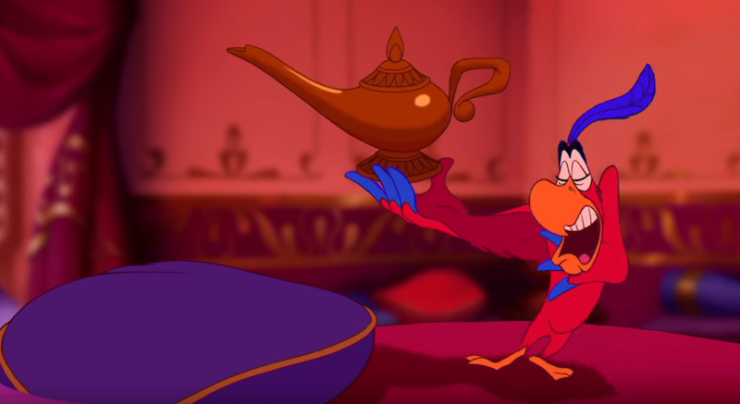
Named after one of Shakespeare’s most infamous traitors, Iago is magic insofar as he’s really just Gilbert Gottfried as a parrot. Is he useful for Jafar? Well, sometimes, sort of. He’s got the ability to spy on occasion, provided he’s got the appropriate flamingo stilts. And he does have a parrot’s ability to mimic down to a level of realism that no bird has ever achieved. But Iago’s real magical abilities are more down to his particular knack for riling up Jafar just enough that truly horrible schemes are enacted. Every time the parrot reminds the sultan’s advisor how much he hates his job, Jafar’s Evil Meter gets bumped up a few points and the gears start turning toward malevolent ends. The best part is, Iago’s anger in all this comes down to a few past-prime crackers. If Jasmine’s dad would stop feeding him subpar carbs, he’d probably stop complaining altogether.
Matthew—The Sandman by Neil Gaiman
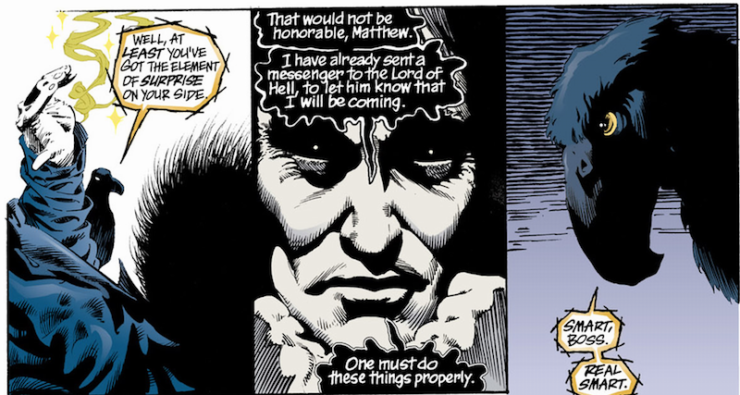
Matthew was not always a raven! He started life as a man, Matthew John Cable, a government agent who was close riends with the experimental biotech engineers Alec and Linda Holland. After they’re murdered, and Alec’s consciousness is kind of rebooted by Swamp Thing, he spends years either hunting Swamp Thing or protecting him, falls in love with Swampy’s other guardian, Abigail, has a tumultuous relationship with her, gets wounded in a car wreck, is rescued by Abbigail’s occultist uncle, accidentally allows Abigail’s uncle to use his body as a conduit to escape Hell, resurrects Abigail after her uncle kills her, and ends up in a coma…until his organs are harvested by corrupt nurses. Matthew has had a rough time. But since he died while in the Dreaming, he’s offered the opportunity to become one of Morpheus’ Ravens. He is sarcastic and crude, and spends a good deal of time squinting skeptically at his boss, the Lord of All Dreaming, who can be a bit of drama queen, making him the perfect reader proxy in the midst of all the gothy surrealism of the Gaiman’s comic. Like the reader, he finds himself becoming more and more attached to Morpheus—to the point that he almost quits when his version of the Dream Lord is reborn in his incarnation as Daniel.
The Phoenix—The Phoenix and the Carpet by E. Nesbit
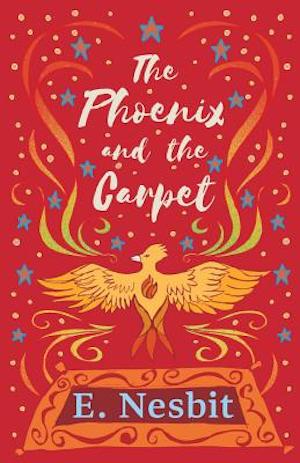
Nesbit’s fantastical children’s trilogy features a couple of mythical creatures, including a “psammead”—essentially a sand sprite—a magic carpet, and a great fantasy birb in the form of a bitchy Phoenix. The five children, Cyril, Anthea, Robert, Jane and the Lamb (so called cause he’s the baby) accidentally set their nursery on fire with Guy Fawkes Night fireworks. Their mother than inadvertently replaces it with a magic carpet, that has an egg hidden in it. When middle child Robert knock the egg into the fireplace, a great phoenix emerges. The Phoenix can grant wishes up to a point, which leads to all sort of Classic British Children’s Literature-type adventures. But where the book really sings, I think, is in the Phoenix’s clash with Edwardian London. First he’s ecstatic to find the Phoenix Fire Insurance Company, because he thinks it’s a temple. Later, when the kids take him to a Christmas pageant, he gets so excited that he sets the theater on fire. (There’s a lot of fire in this book? But don’t worry, he wishes all the damage away.) The book stays true to Phoenix lore, though, with the bird coaching the kids through a ritual immolation so he can be reborn in his own egg.
The Hawk(e)—Ladyhawke
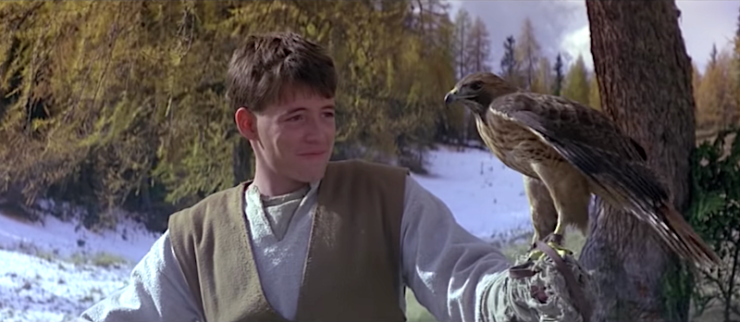
Ladyhawke is one of our greatest ’80s fantasies, and one of the best fairy tale riffs of all time. The story, in brief: two lovers, Isabeau and Etienne, are cursed by a corrupt, devil-worshipping bishop who’s in love with Isabeau. By day, Isabeau is a magnificent hawk, perched on Etienne’s arm as he rides across the French countryside. By night, Etienne is a ravenous wolf, traveling close to Isabeau, but always vulnerable to poachers. One of the many strengths of the film is the way it allows the pair to be animals when they’re in their animal forms. When Etienne is a wolf he can protect Isabeau in certain ways, but he’s still a wolf—he’s incapable of what a human would consider rational thought, and endangers himself constantly. Isabeau-the-hawk is loyal to Etienne for reasons her hawk self probably doesn’t understand, but she’s still a wild-eyed, predatory raptor. When the pair enlists a thief named Philippe to help them end their curse, the film takes the time to show this poor boy attempting to interact with what are, at heart, wild animals, and does a fantastic job of shading those scene from comedy into a desperate sadness as Philippe realizes just how trapped Etienne and Isabeau are.
Hedwig—The Harry Potter Series
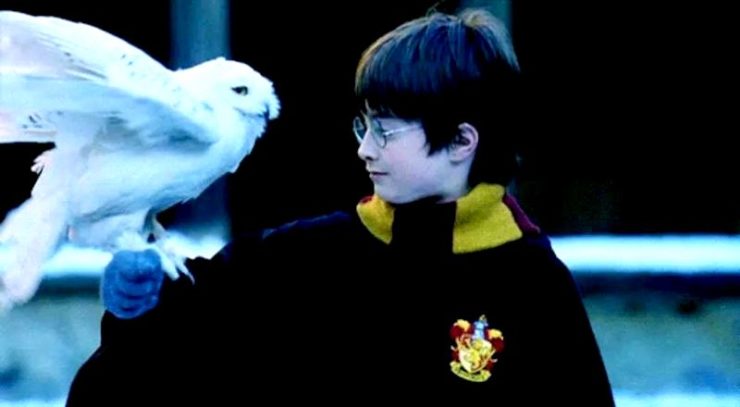
There are plenty of gorgeous birds and half-birds and winged friends in the wizarding world, but Hedwig holds a special place in all our hearts. One of Harry’s first friends in the magical world, the snowy owl was a gift from Hagrid on Harry’s first trip to Diagon Alley. She saw The Boy Who Lived through all his years at school, delivering special secret correspondence and nipping at Harry’s fingertips whenever she was annoyed with him. In a world full of messenger owls, Hedwig always seemed a touch above the rest, capable of finding nearly anyone Harry needed to contact, and always waiting for him when he got home. Her death at the beginning of The Deathly Hallows was potent signifier of just how terrible things were about to get, a sudden moment with no time to truly mourn her. A being whose very presence was indicative of home and safety was ripped from Harry in an instant.
The Raven King—Jonathan Strange & Mr Norrell
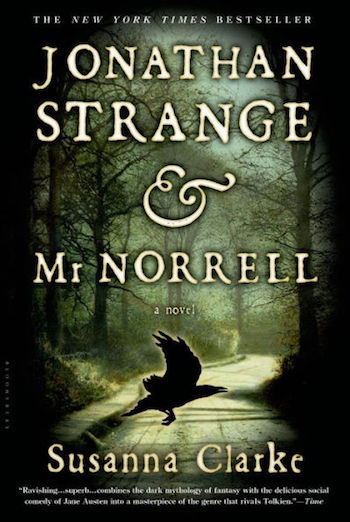
Okay, so he’s more a being than a bird, but the Raven King’s presence usually does result in an overabundance of ravens, and those ravens are a sure harbinger of magic. The Raven King himself is (was) a man known as John Uskglass, England’s greatest and most illustrious magician, who ruled the north of the country for 300 years and was credited with bringing magic into England. His disappearance into Faerie in the 15th century resulted in the decline of magic in England, and all hopefuls of the discipline dearly hoped his return might spark a return of magic to the land. This was eventually circumvented by new magicians—two in particular, by the names of Strange and Norrell—who brought magic back themselves, though not without heavy research into the Raven King and his doings. But given that Strange and Norrell spend most of the novel pitted against one another in their heated argument about the nature of the Raven King and the direction of English magic (and eventually find themselves trapped together in a spell of “Eternal Night” at the end of the book)…maybe don’t go chasing ravens, y’all.
Bubo—Clash of the Titans
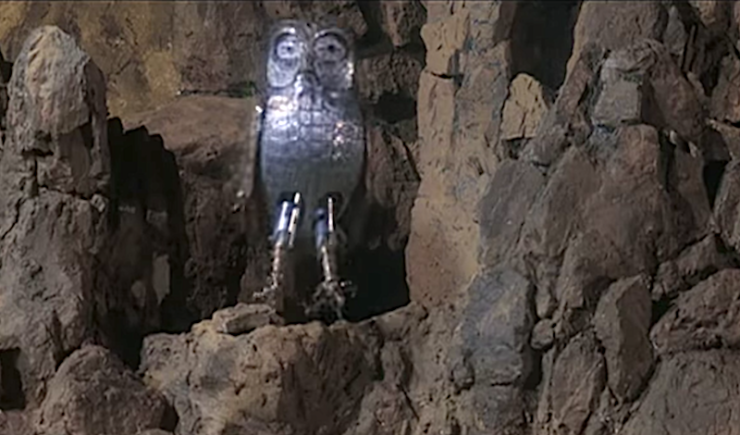
The reason Bubo is one of the best birds of fantasy is that he makes no fucking sense. I mean, okay, Athena is wise, therefore she has an owl perched on her shoulder much as a pirate would have a parrot. Cool. But he’s named BUBO. In what universe does Grey-Eyed Athena name her beloved sidekick something so silly? Athena doesn’t do silly. (And yes, we know it’s the Latin word for owl, but that only makes it sillier—give him a proper name, Athena!) When Zeus orders her to send the bird to help Perseus, she instead has Hephaestus smelt a wonky metal owl who can’t fly. Seriously, he only manages to fly like a foot before he crashes, and every single time he lands he topples over onto his face. But despite everything against him, Bubo 2.0 still helps save the day! At the climax of Clash of the Titans, he’s the one who stages a rescue mission to free the imprisoned Pegasus, who then flies to Perseus’ rescue just when it looks like the Kraken is going to win the day and eat everyone.
Ugh Bubo’s just the best.
Scrooge McDuck—DuckTales
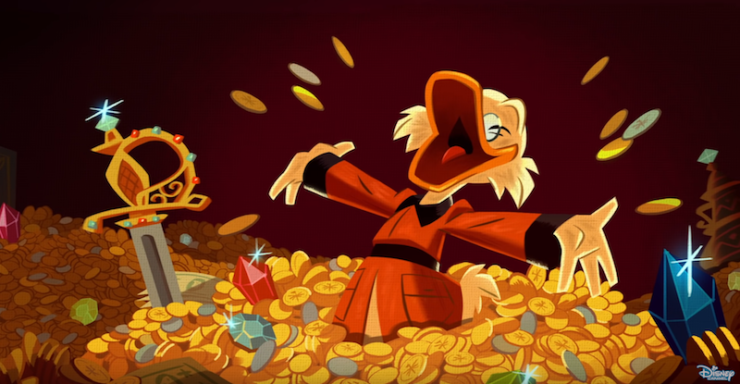
Uh, do you know any other ducks rich enough to defy physics and swim in a pool of gold coins? We didn’t think so.
Originally published in August 2019.










